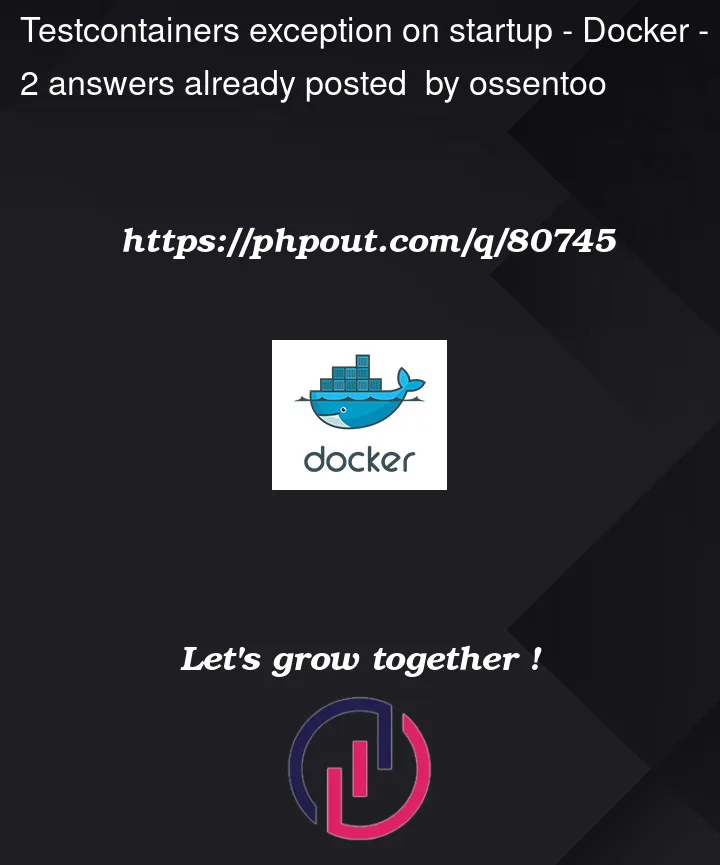Does anyone know why I sometimes get exception when I use Selenium together with Testcontainers. See below:
Exception has occurred: CLR/OpenQA.Selenium.WebDriverException
An exception of type ‘OpenQA.Selenium.WebDriverException’ occurred in WebDriver.dll but was not handled in user code: ‘An unknown exception was encountered sending an HTTP request to the remote WebDriver server for URL http://localhost:4444/session. The exception message was: An error occurred while sending the request.’
Inner exceptions found, see $exception in variables window for more details.
Innermost exception System.IO.IOException : The response ended prematurely.
at System.Net.Http.HttpConnection.d__61.MoveNext()
This happens half the time when i run the following test constructor (C# / xUnit.net):
public DockerShould()
{
var gridNetwork = new NetworkBuilder()
.WithName("gridNetwork")
.Build();
const int SessionPort = 4444;
var containerHub = new ContainerBuilder()
.WithImage("selenium/hub:4.8")
.WithName("selenium-hub")
.WithPortBinding(4442, 4442)
.WithPortBinding(4443, 4443)
.WithPortBinding(SessionPort, SessionPort)
.WithNetwork(gridNetwork)
.Build();
var firefoxEnvironment = new Dictionary<string, string>()
{
{"SE_EVENT_BUS_HOST", "selenium-hub"},
{"SE_EVENT_BUS_PUBLISH_PORT", "4442"},
{"SE_EVENT_BUS_SUBSCRIBE_PORT", "4443"}
};
var containerFirefox = new ContainerBuilder()
.WithImage("selenium/node-firefox:4.8")
.WithEnvironment(firefoxEnvironment)
.WithNetwork(gridNetwork)
.Build();
var firefoxVideoEnvironment = new Dictionary<string, string>()
{
{"DISPLAY_CONTAINER_NAME", "firefox"},
{"FILE_NAME", "firefox.mp4"}
};
var containerFirefoxVideo = new ContainerBuilder()
.WithImage("selenium/video:ffmpeg-4.3.1-20230210")
.WithNetwork(gridNetwork)
.WithEnvironment(firefoxVideoEnvironment)
// .WithWaitStrategy(Wait.ForUnixContainer().UntilPortIsAvailable(SessionPort))
.Build();
gridNetwork.CreateAsync().Wait();
containerHub.StartAsync().Wait();
containerFirefox.StartAsync().Wait();
containerFirefoxVideo.StartAsync().Wait();
Thread.Sleep(5000);
_remoteWebDriver = new RemoteWebDriver(new Uri("http://localhost:4444"), new FirefoxOptions());
}
The exception occurs when creating the new RemoteWebDriver. I’ve added a thread.sleep to give a bit of a delay before the variable is created. I’m not sure it’s really helping much. Is there a more elegant way to ensure all containers are started up before attempting to create the web driver (which i’m assuming is the problem)?




2
Answers
Your configuration has a few shortcomings. I am uncertain as to which one is ultimately causing the issue, but I have provided a working example below. The crucial parts have been commented. Please note that the example does not incorporate a wait strategy to determine the readiness of the container or the service inside it. That is an aspect that you will still need to address. But first lets take a look at some basics.
WithPortBinding(4444, 4444). To prevent port conflicts, assign a random host port by usingWithPortBinding(4444, true)and retrieve it from the container instance usingGetMappedPublicPort(4444).WithNetworkAliases(string)instead.localhostto access services running inside containers. The endpoint varies according to the Docker environment. Use theHostnameproperty instead.I will like to ask you please: What do you use hub and node selenium mode?
I recommended using in this case standalone mode – and why?
Because the webDriver testcoaniner in my opinion works like a dynamic grid in s: docker-selenium github
I am also asking because I just working on that: Feature- WebDriver container
So I would like your opinion and how I can map between the testcotanienr and the RemoteWebDriver capabilities